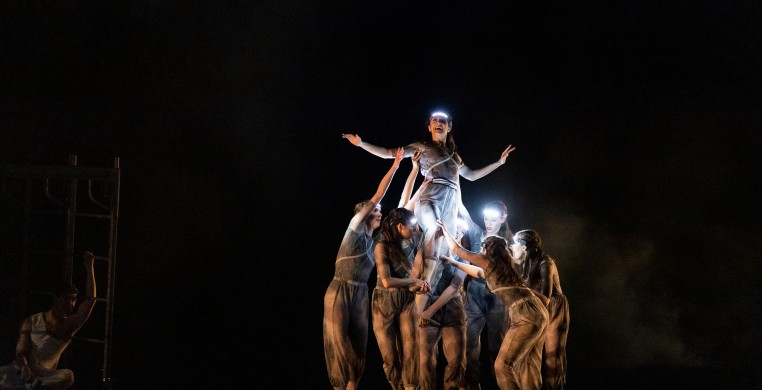October is a prime time for release, renewal and the celebration of culture; it is also Hispanic heritage month. Ballet 5:8’s proud Mexican American founder and choreographer Julianna Rubio Slager honors her culture through her chosen medium of dance. Her latest revival of “BareFace” returns this fall to the Athenaeum Center in Chicago, Oct. 18 - 21, furthering a celebration of distinction, love and what it means to be Hispanic at this moment in history.
I had the pleasure to preview “BareFace” in its early stages in March and I must say I am always impressed by the level of care and intention in Ballet 5:8’s performances. Although the intimate preview at the 1929 Art Deco Carbide and Carbon building at the Pendry Chicago Hotel differed from the stage performance at the Harris Theatre Chicago this past spring, mostly in terms of scale, the new revival at the Athenaeum Theatre promises to bring a fresh rendition in their eleventh season. If you missed the epic premieres in the Spring, no worries, BareFace is back!
Some new features include evolved costumes, designed by Head of Wardrobe Lorianne Robertson, to increase clarity, a fuller cast, and a few edits from feedback which Rubio Slager admits have helped the performance to become more enduring. “BareFace” is the embodiment of many of Ballet 5:8’s core values—to be sustainable, accessible, faith-based and give voice to the unsung.
Although there are a few notable changes, Rubio Slager has assured us that the meat of “BareFace” will remain, the contemporary style choreography, the impressive 95-percent recycled props, imagined by set designer Graham Louthan, which were found through upcycling and Facebook marketplace. The central theme of the performance will also remain, which was inspired by a conversation between Rubio Slager and her son about ancient Greek mythology.
“If you are unfamiliar with the Greek myth, “Cupid and Psyche,” it is a story about love and its shadow side of jealousy,” says Rubio Slager. “The fictitious character in ‘BareFace,’ Orual, endures an abusive father and she has to decide if she will be like him or be different and choose love.” Similarly, the core of “Cupid and Psyche” is rooted in sibling rivalry that reminds us of the dangers of women not standing together. “’BareFace’ teaches us to dive into ourselves to understand our own motivations, how our experiences impact us for both good and bad, or put a mask on the parts we can’t accept. The re-opening of the mask in the myth of Cupid and Psyche is relevant to our society today,” says Rubio Slager.
Although the myth draws from deep-seated jealousy between sisters, there are parts of the performance that point towards the unification of women.
“In the Mines” was one of my favorite pieces in the spring preview. As I recall my reflection of the piece in an earlier review, my excitement increases as I think about how this piece has expanded with time, more dancers, and women solidarity.
A coughing chorus of female dancers disjointedly explored the ground, projecting earthy sounds of deep breath and grunts. Dazzled with headlamps that performed a luz filled spectacle of their own, “In the Mines” is so different from the upright splendor we are accustomed to with Ballet 5:8. It releases perfection of shape and creates organic freedom that keeps us engaged as we witness what is destined to come if we continue to overconsume and be unconscious of labor.
We are truly lucky to have a chance to get into the brilliance of “BareFace” for four additional days. Packed with themes of otherness, attraction, and post-apocalyptic references, it celebrates women, through choreography, projected images by Sarah Freedman and even one of the lead dancers Lorianne Robertson making her debut after maternity leave.
“BareFace” reminds us that ballet is for everyone. It is for the caretaker, the one who is taking care of culture, the people, the planet.
As for the future of Ballet 5:8, Rubio Slager reminds me they are brimming with women’s empowerment as the company prepares for the opening of “The Lost Women of Juarez,” a deeply personal story inspired by Rubio Slager’s tía, scheduled to premiere January 20th at Museum 21C along with a few more surprises, including a work set by choreographer Steve Rooks, former dancer with the Martha Graham Company, in April.


